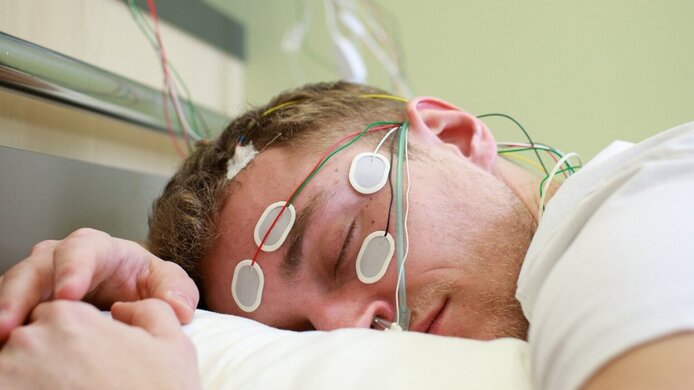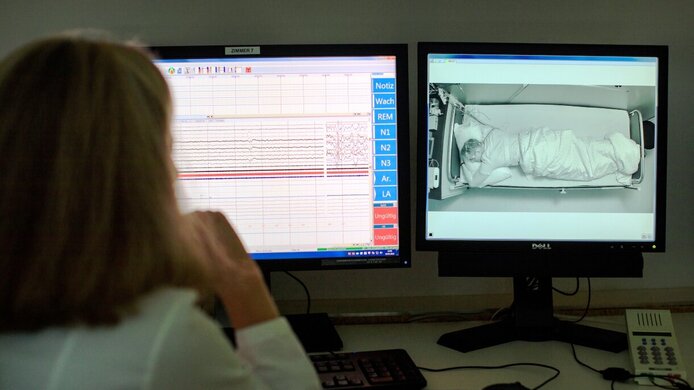How much twitching is normal during sleep?

In his aphorisms on wisdom, Arthur Schopenhauer compared human sleep with winding up a clock. But how much movement healthy sleep entails remained undefined for ages, and existing data were largely obsolete according to Birgit Högl, head of the sleep laboratory at the Department of Neurology at the Medical University of Innsbruck: “What we know about 'normal' movements during sleep partly stems from the days when the sleeper was observed through a window and observations were noted down by hand. At that time, only clearly visible and pronounced movements such as turning, twitching or spasms were recorded. In order to diagnose a sleep disorder we now simultaneously record brain wave curves, eye movements, muscle tension in the chin, arms and legs, various respiratory parameters, ECG, sound and infrared video in the laboratory”, explains Högl. Funded by the Austrian Science Fund FWF, the project Motor activity during sleep in health and disease collected representative and up-to-date standard values for physiological sleep, which aroused great international attention.
Dreamers ought not to move
Since many sleep disorders become manifest in an unusual degree of motor activity, this clinical basic-research project focused on determining normal levels of movement. One hundred women and men (60/40) aged between 19 and 77 were examined. The test subjects were pre-selected by a market research institute on the basis of a questionnaire interview. This was followed by a detailed interview about medical aspects of sleep at the University Clinic for Neurology in Innsbruck so as to exclude people with clinically relevant sleep disorders such as difficulty falling asleep or sleeping through the night, restless legs syndrome, sleepwalking, acting out dreams, narcolepsy or other illnesses involving an excessive tendency to fall asleep during the day, disturbances of the sleep-wake rhythm or indications of breathing disorders during sleep. In this way, 100 “healthy sleepers” were finally selected from a group of more than 400. At the sleep laboratory they were then wired up in accordance with the current state of the art.
Healthy sleep also involves movement
During the dream phase (REM sleep) the muscle activity of healthy people is ‘turned off’. This makes sense, as they might otherwise endanger themselves and others while acting out dream content. The precise measurements conducted by the team told them a lot about what qualifies as “normal”. “Even super-healthy sleepers do move more during the night than we expected”, notes Birgit Högl in the interview with scilog. During REM sleep (dreaming) and non-REM sleep, several muscle twitches per hour were recorded in healthy individuals – with a greater number in men than in women. The clinical significance of small irregular muscle twitches, which can be seen in the video and the muscle recordings, is still unclear. But they could simply be related to the individual's present physical or mental state. The American Academy of Sleep Medicine (AASM) will probably have to revise its guidelines on the degree of muscle twitching that is categorised as pathological. Muscle movements during the dream phase, on the other hand, foreshadow neurodegenerative diseases such as Parkinson's disease. This sleep disorder occurs on average more than ten years before other physical symptoms become noticeable. Recent studies indicate that such a REM sleep disorder is found in up to six percent of people over 50 years of age. The results of the FWF project are currently being further developed in two follow-up projects. There is now a bilateral project (Austria-Argentina) investigating simple screening methods for REM sleep disorders, and the Austrian Institute of Technology (AIT) is working on the automated 3D analysis of movements during sleep. Birgit Högl is one of the editors of the world’s first comprehensive compendium on REM sleep behaviour disorder which has just been published by Springer.
Personal details
Birgit Högl is an Associate Professor of Neurology and head of the Sleep Laboratory at the University Clinic for Neurology, Medical University of Innsbruck. A graduate of the Munich University of Technology, she did research on extrapyramidal disorders and sleep in Buenos Aires, Argentina and at the Max Planck Institute for Psychiatry in Munich.
Publications
Schenck, Carlos H., Högl, Birgit, Videnovic, Aleksandar (Eds.): Rapid-Eye-Movement Sleep Behavior Disorder, Springer 2019
Högl B, Stefani A, Videnovic A.: Idiopathic REM sleep behaviour disorder and neurodegeneration – an update, in: Nature Reviews Neurology 2018
Stefani A, Heidbreder A, Brandauer E, Guaita M, Neier LM, Mitterling T, Santamaria J, Iranzo A, Videnovic A, Trenkwalder C, Sixel-Döring F, Wenning GK, Chade A, Poewe W, Gershanik OS, Högl B.: Screening for idiopathic REM sleep behavior disorder: usefulness of actigraphy, in: Sleep 2018






